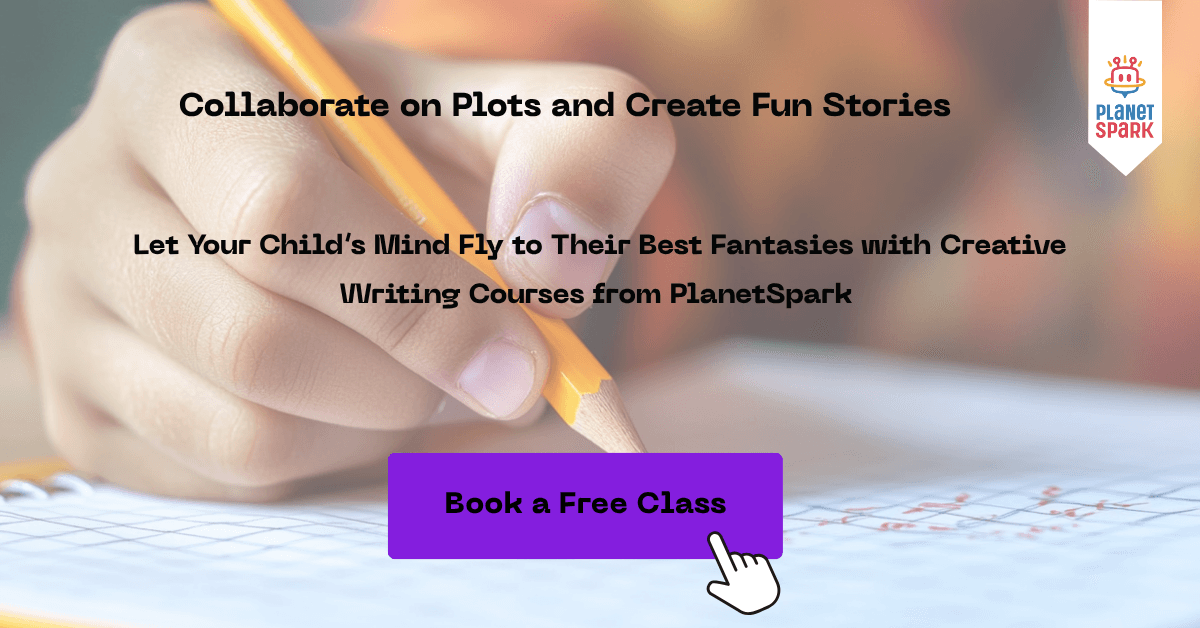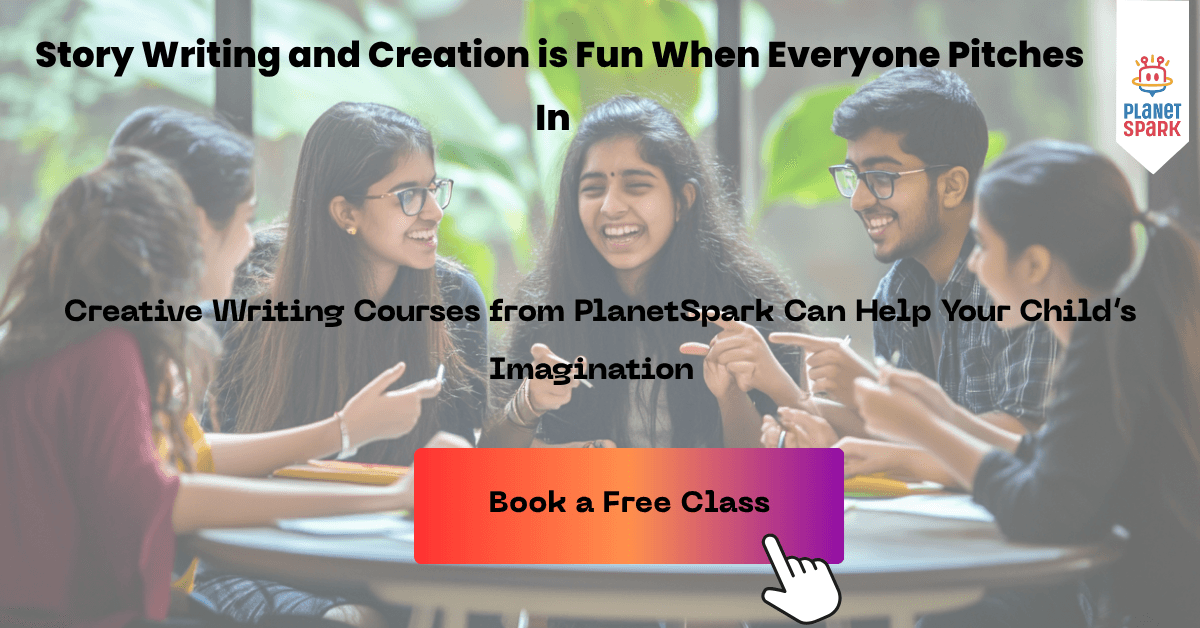PlanetSpark Guide: Mad Lib Writing Prompts for Class 5

Table of Contents
- What Are Mad Libs?
- Educational Value of Mad Libs for Class 5 Students
- Sample Mad Lib Writing Prompt Worksheet
- How to Create Your Own Mad Lib Style Writing Prompt
- Creative Ways to Use Mad Lib Prompts in Class
- At-Home Mad Lib Activities for Parents and Kids
- Make Your Own Mad Lib with These Sources
- Sample Word Bank for Mad Libs
- PlanetSpark’s English Writing Course: Empowering Future Auth
- Conclusion
- FAQs
Mad Libs are more than a fun word game—they’re a creative and engaging way for 5th-grade students to develop grammar, vocabulary, and storytelling abilities. These prompts introduce core language concepts like nouns, verbs, adjectives, adverbs, and interjections through a humorous and playful format. This not only enhances language comprehension but also makes writing less intimidating. Children are encouraged to think imaginatively and explore different parts of speech in a hands-on way.
PlanetSpark’s Creative Writing Course for Class 5 complements this type of learning by offering a structured, innovative path to writing mastery. With personalised 1:1 trainer support, gamified activities such as SparkBee, digital writing practice via Spark Diary, and AI-driven feedback through SparkX, the course transforms young learners into confident and expressive writers. Whether your child is just starting or is already passionate about writing, PlanetSpark offers them the ideal environment to grow and thrive.
What Are Mad Libs?
Understanding the Concept of Mad Libs
Mad Libs are phrasal template word games that invite players to fill in the blanks with random words, usually without seeing the context. When the story is revealed, the results are often silly and hilarious, making them a hit among kids and adults alike. These prompts add an element of surprise and encourage spontaneous word use, helping students become more comfortable with language.
Give your child a head start in creative writing with PlanetSpark’s Creative Writing Course
Why Mad Libs Are Effective for Class 5
- Boost vocabulary and grammar skills through repetition and play
- Encourage students to understand and apply sentence structure
- Make learning interactive and enjoyable
- Improve social and teamwork skills in group activities
- Spark creativity and storytelling through improvisation
Nurture your child’s grammar and storytelling skills with PlanetSpark’s personalised training.
Educational Value of Mad Libs for Class 5 Students
Key Learning Benefits
Grammar Reinforcement
Mad Libs involve every part of speech—nouns, verbs, adjectives, adverbs, and interjections—helping children enjoyably reinforce grammar rules. Students naturally learn grammar as they plug different words into the blank spaces.
Vocabulary Building
Random word insertion exposes children to new terms they might not typically use. Over time, this improves both their written and spoken vocabulary.
Improved Sentence Structure
Reading out Mad Libs after completion helps students understand how word order and syntax impact meaning. This reinforces sentence-building skills.
Creativity and Humor
The unexpected combinations that arise from random word choices create laughter and excitement, encouraging even reluctant learners to participate actively.

Sample Mad Lib Writing Prompt Worksheet
Here’s an example of a completed Mad Lib worksheet:
Sample Mad Lib Story
Title: "The Sleepover Saga"
Peter (Person in Room) asked if I wanted to sleep over, and I said, "Son of a Nincompoop!" (Exclamation). That sounds groovy (Adjective), but I will have to ask my cat (Noun) for permission. So, I went to Mom, and she said, "Ask your stilettos" (Noun). So, I asked my stilettos again, and they said, "Ask your birthday cake" (Noun). I said, "Is anyone here capable of making an iPhone?" (Noun).
Then, my dad yelled at me and said, "Don’t get sassy (Adjective) with me, young feather" (Noun). Now, go to your babysitter (Noun). I complained to Mom that this was not fair, but she said, "Life is unpredictable" (Adjective). I dropped the subject and moved away eagerly (Adverb), fighting back racks (Plural noun).
The next day, Suzanne (Person in Room) called me and asked me over for dinner!
Encourage your child to write their own hilarious Mad Libs with support from expert trainers at PlanetSpark.
How to Create Your Own Mad Lib Style Writing Prompt
Step-by-Step Guide for Customisation
Step 1: Choose a Theme or Topic
Pick a setting or theme that interests the students:
- Holidays like Christmas or Diwali
- A school field trip or event
- A family picnic or birthday party
- A magical or mysterious adventure
Step 2: Write a Short Story
Keep it simple and engaging:
- Write 100 to 200 words
- Use short sentences
- Introduce a few characters or a fun scenario
Step 3: Identify and Replace Key Words
Switch out parts of speech with blanks:
- Label blanks with the required word type (e.g., [Noun], [Verb])
- Use a variety of parts of speech to keep it dynamic
Step 4: Reread and Finalise
Check for flow and humor:
- Read the story aloud using placeholders
- Add silly or dramatic elements to entertain readers

Creative Ways to Use Mad Lib Prompts in Class
Classroom Activities with Mad Libs
Flashcard Vocabulary Game
Prepare cards labeled with different word types. Students draw cards and use them to fill in a blank story template.
Group Writing Exercise
Divide the class into groups and assign different Mad Lib templates. Let each group perform their completed story in front of the class.
Reading and Highlighting Game
Distribute a passage or poem and have students highlight different parts of speech. Then, rewrite the story with blanks for Mad Lib use.
Mad Lib Relay
Form a circle. Each student fills in one blank and passes it on. This encourages teamwork, quick thinking, and vocabulary application.
Make classroom writing fun and effective, explore PlanetSpark’s gamified writing lessons.
At-Home Mad Lib Activities for Parents and Kids
Turning Fun into Learning at Home
DIY Mad Lib Books
Encourage children to create themed Mad Lib books using ideas like sports, fairy tales, or daily routines. This turns writing into a creative art project.
Family Game Night
Make Mad Libs a regular part of family bonding. Assign rotating roles—one reads, others suggest words. This keeps everyone involved and entertained.
Mad Lib Story Videos
Have children record themselves reading their Mad Lib stories. Play back the videos to enhance fluency, pronunciation, and self-confidence.
Strengthen your child’s home learning routine with PlanetSpark’s Creative Writing tools and journals.
Make Your Own Mad Lib with These Sources
Suggested Sources for Templates
Inspiration can come from everywhere:
- Birthday cards or greeting cards
- Articles from magazines or newspapers
- Well-known poems and rhymes
- Descriptions on food packaging or toys
- Short stories from children's books
Learn how to convert any text into a fun writing prompt with expert help from PlanetSpark.
Sample Word Bank for Mad Libs
Helpful Word Categories
Having a word bank ready speeds up the process and guides younger learners:
Common Nouns
- Dog, School, Pencil, Pizza, Chair, Balloon
Adjectives
- Silly, Bright, Loud, Curious, Tiny, Excited
Verbs
- Jump, Laugh, Slide, Think, Build, Scream
Adverbs
- Swiftly, Loudly, Cheerfully, Anxiously, Sneakily
Interjections
- Wow! Oh no! Hey! Yippee! Oops!
Help your child expand their vocabulary with PlanetSpark’s curated word games and activities.
PlanetSpark’s English Writing Course: Empowering Future Authors
At PlanetSpark, we believe that every child has the potential to be a compelling storyteller. Our English Writing Course is designed to turn that potential into confident expression through structured, fun, and interactive learning.
1:1 Personal Trainers for Every Child
Each learner is paired with a dedicated language expert who:
- Understands their pace, interests, and goals
- Provides instant corrections and guidance
- Focuses on speaking, writing, grammar, and creativity
Personalised Curriculum and Learning Roadmap
A customised plan that:
- Pinpoints language gaps
- Provides targeted grammar and writing modules
- Evolves as the child grows
SparkX – AI-Enabled Video Analysis Tool
Students submit videos and receive feedback on:
- Clarity of speech
- Sentence structure
- Presentation style
- Confidence and eye contact
AI-Led Practice Sessions
AI coaches guide children through:
- Mock speech deliveries
- Storytelling practice
- Instant fluency feedback
Spark Diary – Digital Writing Journal
Students regularly write:
- Personal reflections
- Poems and essays
- Stories based on prompts
Gamified Learning
Kids stay motivated through:
- Grammar and vocab challenges
- Spell Knockout and Antonym Quizzes
- Leaderboards and fun rewards
Parent-Teacher Meetings
Regular check-ins include:
- Performance reports
- Learning updates
- Joint planning for next steps
Comprehensive Reports
Parents receive detailed evaluations covering:
- Writing quality
- Grammar accuracy
- Speaking fluency
- Confidence level
Exclusive Learning Communities
Students join engaging clubs:
- Story Writers Guild
- Debate Circles
- Podcast and Poetry Collectives
Sparkline – Safe Content Sharing Platform
Kids build digital confidence by:
- Sharing written or video content
- Engaging with peers in a moderated space
Contests and Recognition
Opportunities to shine include:
- National storytelling competitions
- Live poetry showcases
- Creative writing challenges
SparkBee & SparkShop
- SparkBee: Daily grammar drills and spelling games
- SparkShop: Downloadable eBooks tailored to every grade
Conclusion
Mad Lib style writing prompts aren’t just fun—they’re a smart, effective way to enhance a child’s language skills. These prompts turn grammar practice into laughter-filled learning, promoting creativity and critical thinking. When paired with PlanetSpark’s English Writing Course, the benefits multiply.
At PlanetSpark, your child receives personalised coaching, access to cutting-edge tools, and plenty of encouragement to write, speak, and express with confidence.
Start your child’s writing journey with PlanetSpark today!
Unlock the joy of writing with expert trainers, interactive tools, and a personalised curriculum. Explore PlanetSpark’s English Writing Course now!
FAQs
1. What is the purpose of Mad Lib-style prompts for Grade 5?
Mad Libs help students learn grammar in a fun, interactive way while boosting creativity and confidence in sentence construction.
2. How do I start an introduction in a Mad Lib writing prompt?
Begin with a general overview of your topic. Narrow it down to highlight its significance and what you aim to explore.
3. What parts of speech are used in Mad Libs?
- Noun: Person, place, or thing (e.g., dog, city)
- Adjective: Describes a noun (e.g., happy, large)
- Verb: Shows action (e.g., run, eat)
- Adverb: Describes how actions happen (e.g., quickly)
- Interjection: Expresses emotion (e.g., wow, hey!)
4. How long should a Mad Lib story be for a 5th grader?
Ideally, 100–200 words. Keep it short, simple, and age-appropriate.
5. Can Mad Libs improve public speaking skills?
Yes! Reading aloud helps with fluency, intonation, and confidence in speech.
6. Are Mad Libs suitable for classroom activities?
Absolutely. They promote teamwork, critical thinking, and active participation.
7. What makes PlanetSpark’s English Writing Course different?
It offers 1:1 mentorship, gamified tools, AI analysis, digital journaling, and community-based learning to ensure holistic skill development.
Personalized Communication Report
Record a video to get a AI generated personalized communication report for your child

Hi There, want to try these
tips for your child with
LIVE with our expert coach?
Let's check your child's
English fluency
